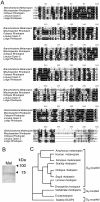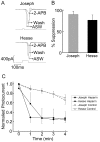Melanopsin-expressing amphioxus photoreceptors transduce light via a phospholipase C signaling cascade
- PMID: 22235344
- PMCID: PMC3250494
- DOI: 10.1371/journal.pone.0029813
Melanopsin-expressing amphioxus photoreceptors transduce light via a phospholipase C signaling cascade
Abstract
Melanopsin, the receptor molecule that underlies light sensitivity in mammalian 'circadian' receptors, is homologous to invertebrate rhodopsins and has been proposed to operate via a similar signaling pathway. Its downstream effectors, however, remain elusive. Melanopsin also expresses in two distinct light-sensitive cell types in the neural tube of amphioxus. This organism is the most basal extant chordate and can help outline the evolutionary history of different photoreceptor lineages and their transduction mechanisms; moreover, isolated amphioxus photoreceptors offer unique advantages, because they are unambiguously identifiable and amenable to single-cell physiological assays. In the present study whole-cell patch clamp recording, pharmacological manipulations, and immunodetection were utilized to investigate light transduction in amphioxus photoreceptors. A G(q) was identified and selectively localized to the photosensitive microvillar membrane, while the pivotal role of phospholipase C was established pharmacologically. The photocurrent was profoundly depressed by IP₃ receptor antagonists, highlighting the importance of IP₃ receptors in light signaling. By contrast, surrogates of diacylglycerol (DAG), as well as poly-unsaturated fatty acids failed to activate a membrane conductance or to alter the light response. The results strengthen the notion that calcium released from the ER via IP₃-sensitive channels may fulfill a key role in conveying--directly or indirectly--the melanopsin-initiated light signal to the photoconductance; moreover, they challenge the dogma that microvillar photoreceptors and phoshoinositide-based light transduction are a prerogative of invertebrate eyes.
Conflict of interest statement
Figures





References
-
- Salvini-Plawen LV, Mayr E. The evolution of photoreceptors and eyes. In: Hecht MK, Steere WC, Wallace B, editors. Evolut Biol. New York: Plenum Press; 1977. pp. 207–263. (Vol. 10)
-
- Gehring WJ. The genetic control of eye development and its implications for the evolution of the various eye-types. Int J Dev Biol. 2002;46:65–73. - PubMed
-
- Gehring WJ, Ikeo K. Pax 6: mastering eye morphogenesis and eye evolution. Trends Genet. 1999;15:371–377. - PubMed
-
- Berson D, Dunn F, Takao M. Phototransduction by retinal ganglion cells that set the circadian clock. Science. 2002;295:1070–1073. - PubMed
Publication types
MeSH terms
Substances
LinkOut - more resources
Full Text Sources

